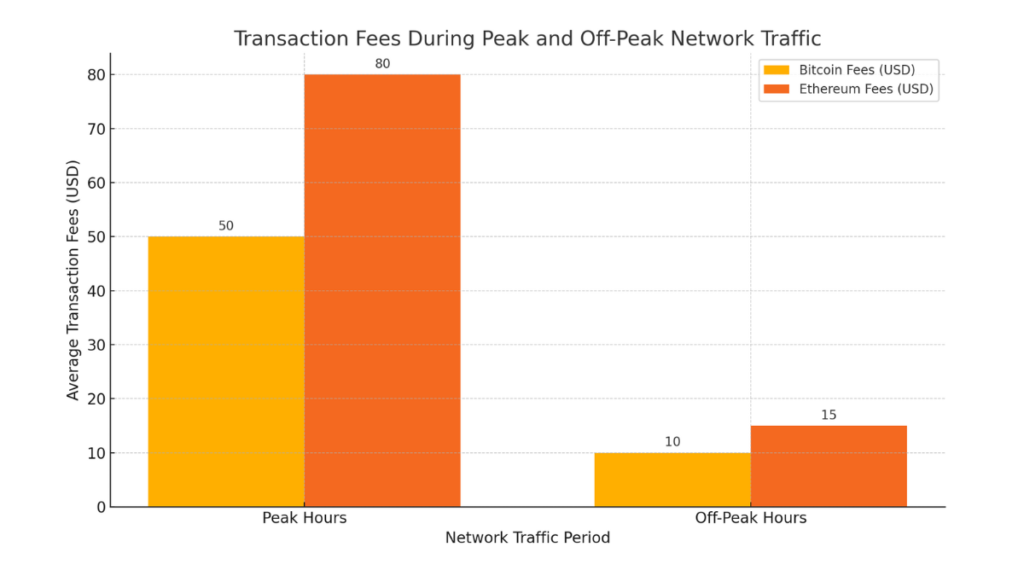Network congestion impact has become a critical factor influencing cryptocurrency prices in 2024. As blockchain networks like Bitcoin and Ethereum continue to experience high transaction volumes, network congestion has emerged as a significant driver of crypto price fluctuations. This congestion often leads to increased transaction fees and delays, affecting the crypto market’s overall stability. Notably, recent examples such as Bitcoin’s price drop to $27,000 due to network congestion and Ethereum’s struggles with gas fee spikes highlight how network inefficiencies directly influence market dynamics. These incidents underscore the importance of understanding real-time crypto price changes during congestion and the broader market response to such network events.
How Network Congestion Impacts Cryptocurrency Prices
Network congestion plays a crucial role in causing price fluctuations in the cryptocurrency market. When blockchain networks like Bitcoin and Ethereum face congestion, transaction fees soar, and delays become commonplace. This results in changes to supply and demand dynamics as traders and investors react to longer wait times and higher costs. During periods of high congestion, such as network spikes caused by surges in transaction volumes, the cost of transacting can rise sharply, affecting trading strategies and overall market sentiment. The direct link between network congestion, transaction fees, and crypto price volatility underscores the need for traders to adapt to these changing conditions.
Transaction Delay Costs and Their Effect on Prices
Transaction delays during network congestion lead to increased costs, compelling traders to pay higher fees to expedite their transactions. This situation often results in price surges or dips, as seen in the Bitcoin and Ethereum networks during periods of heavy traffic. For instance, when network congestion peaks, users may opt to pay higher fees for faster processing, which drives up the overall transaction costs. These elevated fees, in turn, impact market behavior, as traders adjust their strategies based on the fluctuating costs. Consequently, the market may experience increased volatility, with prices reacting sharply to the congestion-induced changes in transaction costs.
Here is a comparative table that illustrates the differences in transaction fees during normal versus congested network periods for Bitcoin and Ethereum:
| Cryptocurrency | Normal Network Period | Congested Network Period |
|---|---|---|
| Bitcoin | $1 – $5 | $20 – $60 |
| Ethereum | $5 – $10 | $30 – $100 |
Note
These values are illustrative and may vary based on real-time network conditions.
During normal periods, transaction fees remain relatively low, allowing traders to execute transactions without incurring significant costs. However, when network congestion spikes, fees can escalate rapidly. For example, Bitcoin’s transaction fees can jump from a few dollars to over $60, while Ethereum’s gas fees can surge to nearly $100 during peak congestion periods. This escalation in fees not only deters trading activity but also impacts crypto prices by introducing a barrier to market entry and liquidity.

Here is a bar chart comparing transaction fees during normal and congested network periods for Bitcoin and Ethereum. This visualization provides a clear side-by-side comparison of how transaction fees escalate during periods of network congestion.
- Normal Period: Represents the average transaction fees during normal network conditions.
- Congested Period: Shows the spike in transaction fees during network congestion.
Real-Time Crypto Price Changes During Network Congestion
Real-time congestion events can lead to immediate price reactions in the crypto market. A notable example is the recent congestion in the Bitcoin network, which led to a price drop to $27,000 amidst the network’s inability to process transactions quickly. Similarly, the Ethereum network has experienced several instances where congestion caused by high transaction volumes resulted in gas fee spikes, subsequently affecting Ether’s price. For instance, during the peak of the decentralized finance (DeFi) boom in 2021, Ethereum transaction fees soared due to network congestion, causing immediate market reactions and prompting traders to either delay their transactions or seek alternative networks.
These real-time price changes during congestion events highlight the interconnectedness of network efficiency and market performance. As transaction delays and high fees persist, traders may resort to panic selling or holding back on transactions, both of which can lead to sudden market movements and increased volatility. The immediate impact of network congestion on crypto prices is a testament to how sensitive the market is to blockchain performance, where any delay or cost increase can trigger shifts in investor sentiment and trading patterns.
Historical Incidents of Network Congestion and Price Fluctuations
Throughout the history of cryptocurrency, network congestion has played a pivotal role in influencing price dynamics. Key incidents, such as the Bitcoin network difficulty spike in August 2024 and the Ethereum network congestion during the DeFi boom of 2021, exemplify how transaction delays and soaring fees can trigger significant market fluctuations. These events serve as crucial case studies for understanding the correlation between network congestion and crypto price volatility, highlighting the market’s sensitivity to network performance.
Bitcoin Network Congestion and Price Surges
In August 2024, the Bitcoin network experienced a significant increase in difficulty, leading to an unprecedented level of congestion. The network’s ability to process transactions quickly was severely hampered, resulting in delayed transactions and escalating fees. As Bitcoin miners struggled to process the growing backlog of transactions, users were forced. This led to a situation where network congestion drove abrupt price shifts. The price of Bitcoin experienced volatility as traders reacted to the rising transaction costs and delayed processing times. Miners responded to the congestion by prioritizing transactions with higher fees, which only fueled the cycle of increasing costs.
The congestion led to a noticeable price dip, as traders and investors, frustrated by the delays and high fees, began offloading their holdings. This incident underscored the delicate balance between network efficiency and market performance. With Bitcoin’s value dropping in response to the congestion, the market showcased its susceptibility to network-related disruptions. These network congestion-driven crypto price shifts demonstrated the direct impact of blockchain performance on market confidence and liquidity.
Ethereum Network Congestion and Gas Fee Spikes
The Ethereum network has had its share of congestion-related challenges, particularly during the DeFi boom in 2021. As the demand for decentralized finance applications surged, the Ethereum network became increasingly congested. This led to a significant spike in gas fees, which are the costs required to execute transactions on the network. Higher transaction volumes pushed the network to its limits, causing delays and making it more expensive to transact. The correlation between Ethereum network congestion and Ether prices became evident as users faced soaring gas fees.
Ethereum Network Congestion Impacts
- Impact of congestion on gas fees: During peak congestion periods, Ethereum gas fees skyrocketed, making it cost-prohibitive for many users to conduct transactions.
- Correlation between gas fees and Ether price: The surge in gas fees often resulted in price volatility for Ether, as traders reacted to the increased costs by altering their trading strategies, leading to sudden price movements.
- Trader responses to high transaction costs: Many traders responded to high gas fees by either delaying their transactions or moving to alternative networks, which further influenced Ether’s price dynamics.
Bitcoin Network Congestion: Price vs. Transaction Fees in 2024:

- This graph shows the relationship between Bitcoin prices and transaction fees over a period of months in 2024.
- The blue line represents Bitcoin prices, while the red dashed line shows the transaction fees. As congestion increases, transaction fees rise, and prices experience volatility.
Ethereum Network Congestion: Price vs. Gas Fees in 2021:

- This graph illustrates how Ethereum prices and gas fees fluctuated during 2021, particularly during periods of network congestion.
- The green line indicates Ethereum prices, and the orange dashed line shows gas fees. The correlation between rising gas fees and changes in Ether prices is evident during high congestion periods.
Key Observations:
Incidents on the Ethereum network demonstrated the effects of transaction congestion on crypto pricing. When transaction fees spiked, the market saw immediate shifts in trading volumes and price trends. This correlation between network congestion and crypto volatility highlighted the critical role that network efficiency plays in maintaining a stable market environment.
Causes of Network Congestion and Their Influence on Crypto Markets
Network congestion in the cryptocurrency market is often triggered by several key factors, including high transaction volumes, network upgrades, and blockchain efficiency issues. These factors collectively contribute to increased transaction delays and elevated fees, thereby influencing the overall market dynamics. High transaction volumes during periods of heightened market activity, such as ICOs or major trading events, often lead to congestion. Similarly, network upgrades aimed at improving scalability or security can temporarily result in slower transaction speeds and price fluctuations. Understanding these causes is essential for navigating the complexities of crypto market behavior in times of congestion.
High Transaction Volumes Leading to Price Volatility
Sudden surges in transaction volumes, commonly observed during ICOs, airdrops, or major market events, can significantly strain blockchain networks. When the network is inundated with an influx of transactions, it leads to congestion, causing transaction delays and driving up fees. For example, during the peak of the 2021 bull market, Bitcoin and Ethereum networks experienced unprecedented transaction volumes. This congestion led to increased transaction fees, prompting traders to react swiftly to avoid excessive costs, thereby creating volatile price swings.
High network traffic also amplifies market sentiment. During periods of network congestion, the market often experiences heightened anxiety and speculation, with traders either rushing to execute trades before fees escalate further or halting activities to avoid high costs. This response to network congestion often results in sharp price movements, exemplifying how market sentiment during high traffic periods can exacerbate price volatility.
Network congestion and crypto volatility are closely linked. For instance, when Bitcoin’s network becomes congested due to a surge in trading activity, transaction delays ensue, resulting in increased costs. Traders who are unwilling to bear these costs may offload their assets, leading to a sudden drop in prices. Conversely, those who are willing to pay the higher fees to expedite their transactions might drive prices up temporarily. This interplay of actions showcases how high network traffic can lead to immediate and unpredictable shifts in the crypto market.

- Line Graph: This graph shows the relationship between Bitcoin transaction volumes (in blue) and Bitcoin prices (in green) over several months. The correlation between high transaction volumes and price volatility is evident, as periods of increased activity lead to fluctuations in Bitcoin’s price.
- Interpretation: As transaction volumes surge, network congestion occurs, often leading to increased price volatility in the crypto market.
Network Upgrades and Their Short-Term Impact on Prices
Network upgrades are crucial for enhancing the scalability, security, and efficiency of blockchain networks. However, they often come with short-term consequences, including network congestion. Ethereum’s transition to a proof-of-stake (PoS) mechanism through the Ethereum 2.0 upgrade is a prime example. While this upgrade aims to improve the network’s long-term performance, the initial phases caused temporary congestion due to the adjustment period required for nodes and miners to adapt to the new protocol. This adjustment period can result in slower transaction speeds and increased fees, thereby impacting Ether prices in the short term.
Similarly, Bitcoin’s periodic difficulty adjustments, designed to maintain a consistent block production rate, can lead to congestion. For instance, when the network adjusts to a higher difficulty level, miners require more computational power to process transactions, which can temporarily slow down the network. During this period, transactions may take longer to confirm, and fees can rise as users compete to have their transactions prioritized. This slowdown can trigger market fluctuations as traders adjust to the changing transaction speeds and costs, often leading to a temporary dip in Bitcoin prices.
Network upgrades, although essential for the future-proofing of blockchain networks, can thus drive market fluctuations. During these periods, network congestion-driven changes in crypto trading volume become evident as traders react to the temporary inefficiencies. Understanding the impact of such upgrades on network performance is key for anticipating market behavior and managing risk effectively.

- Bar Chart: This chart displays the impact of network upgrades on transaction speeds (in minutes) and crypto prices (in USD). Each network upgrade is shown along the x-axis, with corresponding bars representing the change in transaction speeds and crypto prices.
- Interpretation: Network upgrades can temporarily slow down transaction speeds, resulting in short-term price fluctuations. This visualization helps illustrate how these upgrades affect network efficiency and market prices.
Strategies to Mitigate the Impact of Network Congestion on Crypto Prices
Network congestion can pose significant challenges for crypto traders and investors, leading to increased transaction fees and delays. To navigate these conditions effectively, traders and investors can adopt various strategies aimed at mitigating the negative effects of congestion. Solutions such as utilizing Layer-2 scaling technologies and strategically timing trades offer practical ways to minimize costs and maintain market stability even during periods of high network activity.
Utilizing Layer-2 Solutions for Faster Transactions
Layer-2 solutions have emerged as a crucial method for alleviating network congestion on blockchain networks like Bitcoin and Ethereum. These solutions work by processing transactions off the main blockchain (Layer 1) and only settling the final state on the main chain, thereby reducing the load and improving overall transaction speed. Notable Layer-2 solutions include the Lightning Network for Bitcoin and rollups for Ethereum.
- Lightning Network for Bitcoin: This is a Layer-2 protocol designed to enable instant, low-cost Bitcoin transactions by creating off-chain payment channels between parties. It allows multiple transactions to occur off-chain, with only the opening and closing of channels recorded on the main Bitcoin blockchain. This significantly reduces congestion and lowers transaction fees, making it an effective tool for mitigating network congestion impacts on the Bitcoin network.
- Ethereum Rollups: Rollups, such as Optimistic Rollups and zk-Rollups, bundle multiple transactions into a single batch and process them off-chain, subsequently submitting a compressed proof back to the Ethereum mainnet. This process enhances Ethereum’s scalability, increasing the throughput and reducing congestion and gas fees. By improving transaction speed and reducing costs, rollups contribute to market stability, especially during periods of high demand.
Key Benefits of Layer-2 Solutions
- Key Layer-2 solutions and their benefits: Lightning Network for Bitcoin and Ethereum rollups enable faster and more affordable transactions.
- How Layer-2 improves transaction speed: By processing transactions off-chain, these solutions reduce the load on the main blockchain, leading to quicker confirmations.
- Impact on transaction costs and market stability: Lower transaction fees and improved processing times help stabilize crypto prices by reducing the market disruptions caused by network congestion.
Timing Trades to Avoid High Network Traffic
Another effective strategy to mitigate the impact of network congestion is to time trades during periods of lower network activity. By avoiding peak congestion periods, traders can benefit from lower transaction fees and faster processing times. To do this, traders need to monitor network traffic and transaction fee trends actively.
- Monitor Network Traffic: Traders can use blockchain explorers and network monitoring tools to keep track of network activity. For instance, monitoring the Bitcoin mempool or Ethereum gas tracker can provide insights into current network congestion levels. By analyzing these metrics, traders can identify periods when the network is less congested, such as off-peak hours, and plan their transactions accordingly.
- Use Real-Time Blockchain Traffic Updates: Real-time updates on network traffic can aid traders in making informed decisions. Platforms that provide live network data, including transaction fees and confirmation times, can help traders avoid high-traffic periods. Timing trades during these off-peak periods can result in cost savings and reduced exposure to market volatility driven by network congestion.
Note
Implementing these strategies can significantly reduce the financial impact of network congestion on trading activities. By utilizing Layer-2 solutions and strategically timing trades, traders can navigate network congestion more effectively, maintaining profitability and market efficiency.
Transaction Fees During Peak and Off-Peak Network Traffic:

The bar chart illustrating the variation in transaction fees for Bitcoin and Ethereum during peak and off-peak network traffic periods:
- Peak Hours: Represents periods of high network congestion where transaction fees for Bitcoin and Ethereum are significantly higher.
- Off-Peak Hours: Shows the reduced transaction fees during times of lower network activity, highlighting the cost-saving benefits of timing trades to avoid peak periods.
Note
- Basics of Decentralized Finance
- Bitcoin Market Sentiment in 2024
- Impact of US Inflation Data on Crypto
- Gas Fees Trends in Ethereum
Network congestion remains a pivotal factor influencing cryptocurrency prices, affecting transaction fees, delays, and market stability. By employing strategies like Layer-2 solutions and timing trades effectively, traders can navigate the challenges posed by congestion. Looking forward, understanding these mitigation techniques will be crucial in maintaining a balanced crypto market environment.



















